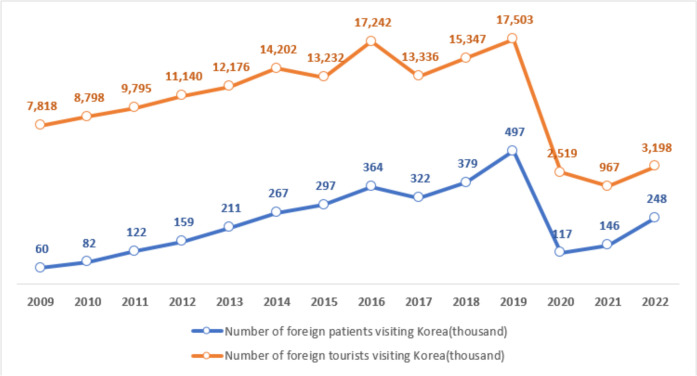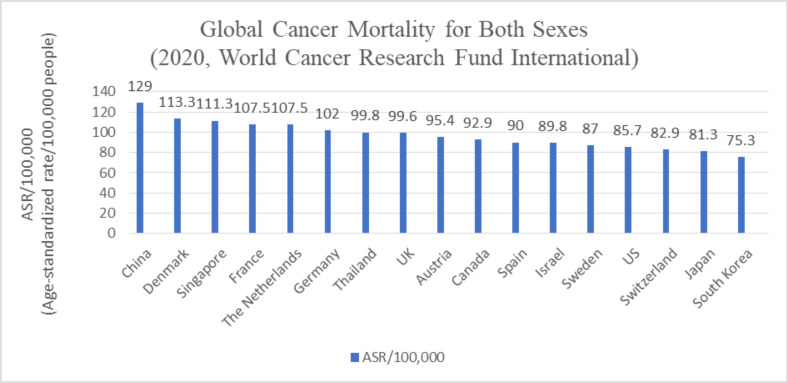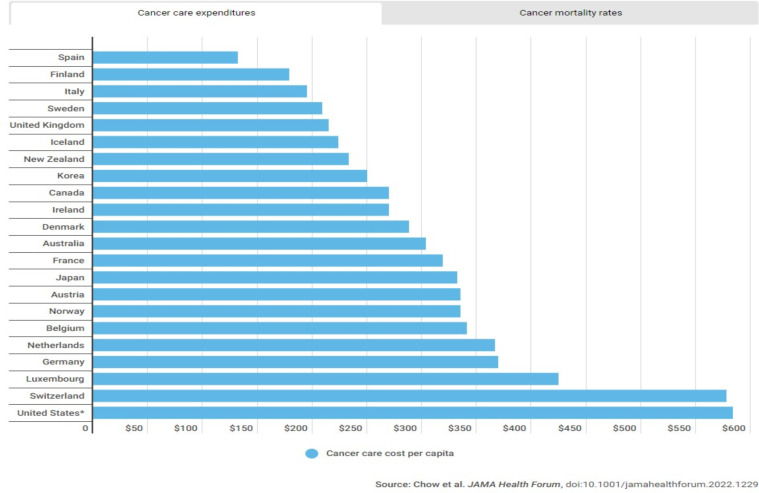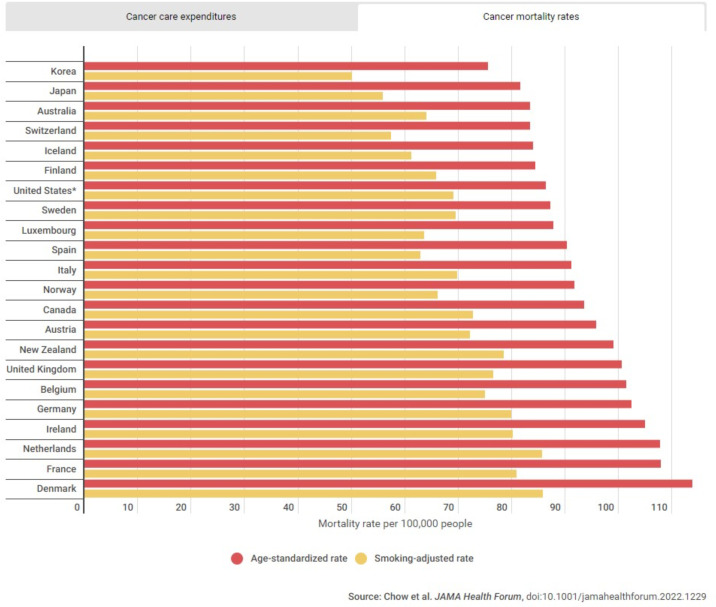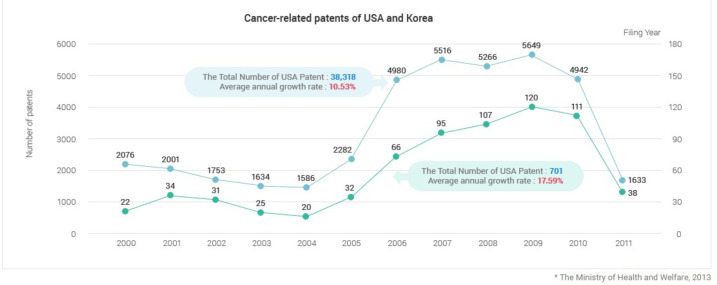Abstract
Background:
Medical tourism is a leading industry of South Korea. Since the transition from the latest health pandemic to endemic, foreign patients have been on a rapid increase. The Korean government regards medical tourism as a major national industry and pursues medical, legal, and policy strategies with the goal of attracting 700,000 foreign patients by 2027.
Methods:
Examining objective data and statistics as well as academic articles, we investigated the strengths and advantages, which might persuade foreign medical tourists to visit South Korea by performing a comparative analysis with high-income or medically advanced countries among Organization for Economic Co-operation and Development (OECD) and other competing Asian countries.
Results:
Cancer is one of the leading causes of death in the world. Compared with other advanced countries and Asian competitors in cancer treatment, South Korea shows excellent result of major cancers treatments, accessibility to hospitals and medical professionals, and competitiveness in terms of surgery and treatment costs.
Conclusion:
South Korea has excellent competitiveness both in price and in cancer treatment with the outstanding results of cancer mortality rates and 5-year survival rates. The achievement of Korea’s cancer treatments is due to accurate diagnosis with the advantage of PET-CT, 64-sllice CT, 3.0 TESLA MRI, etc., and the use of cutting-edge equipment, such as CyberKnife and Da Vince robotic surgery. Besides, the Korean central and local governments actively support for the promotion of Korea’s medical tourism industry, such as issuance of visas for foreigners, the hospital certification system, and medical tourism convergence cluster project.
Keywords: Medical tourism, Censer, Treatment, South Korea
Introduction
The medical tourism industry is a highly value-added industry, and most competitive countries around the world compete to attract foreign patients. According to a report by market research firm Fortune Business Insights, the size of the global medical tourism market was $11.56 billion in 2020. It is expected to grow to $53.51 billion in 2028 with an average annual growth rate of 21.1% (1).
As presented in Fig. 1, medical tourism fell by 34% from US$105 billion in 2019 to US$71 billion in 2020. It has since grown around 15% annually, and in 2023, the market value exceeded 2019 levels for the first time. Furthermore, global medical tourism market by value is expected to grow up to US$182 in 2025 (2).
Fig. 1:
Global Medical Tourism Market by Value (USD Billion) (Source: https://www.consultancy-me.com/)
South Korea also has the interests for the promotion of medical tourists from all over the world. The number of foreign patients visiting Korea in 2022 was 248,000, an increase of 70.1% from 146,000 in 2021, which is a figure that has recovered to 50% compared to 2019 (497,000) before the COVID-19 global pandemic (Fig. 2). In 2009, South Korea attracted 60,000 people, 300,000 people in 2015, and 500,000 people in 2019, but due to the corona pandemic, it decreased to 120,000 in 2020 and increased again to 250,000 in 2022 (4).
Fig. 2:
Foreign patients visiting South Korea from 2009 to 2022 (2)
With cardiovascular disease (CVD), cancer is one of the leading causes of death in the world. Most of all, recent research published in the Lancet reveals cancer is associated with twice as many deaths as CVD in high-income countries (5). In the case of USA, death rates from all cancers combined have been steadily falling over the past decade (1.5% per year since 1993 among men and 0.8% per year since 1992 among women), but in 1999, the number of cancer deaths surpassed heart disease mortality in those younger than age 85(6).
The 10 major cancers worldwide are breast cancer, lung cancer, colon cancer, prostate cancer, stomach cancer, liver cancer, cervical cancer, esophageal cancer, thyroid cancer, and bladder cancer (7). South Korea is the world-renowned leader in cancer treatment (8). Global No.5 and three of the top 20 global hospitals for cancer treatment are based in South Korea. The Korean medical institutions and organizations, such as hospitals, universities, and various research institutes, etc., seek for new medical technologies and methods for cancer treatment. A majority of foreign patients who visit Korea for medical purpose prefer robotic surgeries or laparoscopic surgery to treat various cancers, including colorectal cancer and stomach cancer. Especially, since the incidence of stomach cancer is high in Korea, the abundant clinical experience resulting from this shows excellent results in treating stomach cancer (9–11).
Medical treatment in South Korea is well-known for its high quality, efficiency, and technological advancements, attracting from around the world those who seek specialized treatments and procedures. South Korea has effective health care systems based on national health insurance that all the citizens can join and benefit from. It is proved by the 2021 edition of the CEOWORLD magazine Health Care Index, which ranks 89 countries according to factors that contribute to overall health. Of the 89 countries surveyed, South Korea’s healthcare comes in 1st place on the list scoring 78.72 out of 100 on the Health Care Index in 2021, 2nd place with the score of 82.7, and 3rd place with the 84.8 in 2023 (12). The Health Care Index is a statistical analysis of the overall quality of the health care system, including health care infrastructure; health care professionals (doctors, nursing staff, and other health workers) competencies; cost (USD per capita); quality medicine availability, and government readiness. Even though, such basis are more applicable for residents of South Korea, it is likely that such a well-stablished system can perform an effective role for the foreign patients as well.
With such global recognitions and objective indicators, South Korea potentially plays a leading role in cancer treatment. In particular, we examined cancer treatment, i.e., cancer mortality rate, 5-year survival rate, excellence in cancer treatment including proton/heavy ion therapy treatments, and governmental supports for medical tourism, such as simplification of visa issuance for foreign patients and medical tourism convergence project, etc.
Cancer Mortality Rate & 5-year Survival Rate
The Medical Tourism Index Overall Ranking 2020–2021 (13) was released in July 2020, Canada ranked 1st with a score of 76.47, Singapore (76.43) ranked 2nd , Japan (74.23) 3rd, Spain (72.93) 4th, and United Kingdom (71.92) took 5th place. Dubai and Abu Dhabi took 6th and 9th place with 71.85 and 70.26 respectively. India, which is famous for medical tourism in Asia, ranked 10th with 69.80, and Korea ranked 14th with 68.81.
When compared with its Asian rivals, i.e., Japan, Singapore, India, Thailand, and Dubai and Abu Dhabi with the recently rising popularity, South Korea gained unsatistactory outcomes of a poor performance (Table 1). However, unlike these overall rankings, in the field of cancer surgery and cancer treatment, South Korea performs very well as shown Fig. 3 above in cancer-related achievements rather than European advanced countries (such as England, Spain, Italy, the Netherlands, Germany, France, and England), and North American countries (such as the United States and Canada).
Table 1:
International comparison of 5-year cancer survival rates (unit: %) (16)
| Cancer type | South Korea | USA | Canada | Japan | ||
|---|---|---|---|---|---|---|
|
|
|
|
|
|||
| (1996–2000) | (2006–2010) | (2012–2016) | (2008–2014) | (2006–2008) | (2006–2008) | |
| All cancers | 44.0 | 65.2 | 70.6 | 69.2 | 60 | 62.1 |
| Stomach cancer | 46.6 | 35.1 | 75.8 | 32.1 | 25 | 64.6 |
| Colon cancer | 58.0 | 73.6 | 76.0 | 66.2 | 64 | 71.1 |
| Thyroid cancer | 94.9 | 99.9 | 100.2 | 98.3 | 98 | 93.7 |
| Lung cancer | 12.7 | 20.1 | 27.6 | 19.9 | 17 | 31.9 |
| Breast cancer | 83.2 | 91.1 | 92.7 | 91.1 | 87 | 91.1 |
| Liver cancer | 13.2 | 28.1 | 34.3 | 18.8 | 19 | 32.6 |
| Prostate cancer | 67.2 | 91.1 | 93.9 | 98.9 | 95 | 97.5 |
| Pancreatic cancer | 7.6 | 8.4 | 11.0 | 9.1 | 8 | 7.7 |
| Cervical cancer | 80.0 | 80.6 | 79.8 | 68.9 | 73 | 73.4 |
Fig. 3:
Global Cancer Mortality for Both Sexes 2020 (14)
According to the data pronounced by 2020 World Cancer Research Fund International (14), South Korea recorded 75.3, which is lower than any other medically advanced country, such as Spain (90), Israel (89.8), Sweden (87), USA (85.7), Switzerland (82.9), and Japan (81.3). This is the lowest ASR/100,000 in 2020. Compared with Singapore (111.3), Thailand (99.8), and Japan (81.3), which are famous Asian countries for medical tourism, the record of 75.3 is an excellent score (14).
The survival rate of patients with major cancers in Korea is the highest in the world (https://visitkorea.or.kr/). Especially, the five-year survival rate of stomach cancer patients is 77% in Korea, which is two or three times higher than that of medically advanced countries, such as the US (32.4%) and UK (21.6%) (15). Moreover, approximately 1,000 foreign doctors around the world apply for medical training in Korea to learn the country’s integrated cancer treatment systems, including integrated precision medicine platforms that leverage clinical data on cancer patients in addition to robotic surgeries.F
Korean cancer centers provide one-step services to support prevention, testing, treatment, rehabilitation, and follow-up management. University hospitals and general hospitals as well as 12 government-designated cancer centers offer effective and affordable cancer treatments. As shown below, the 5-year survival rate of cancer patients in Korea is the highest in the world for almost all major cancer types.
Excellence in Cancer Treatment
South Korea’s age-standardized cancer mortality rate was 151.8 per 100,000 people and ranked as the 5th lowest among OECD countries. The OECD average age-adjusted cancer mortality rate was 186.3 (OECD Health Statistics 2021) (17). The United States ranked 13th with 178.3, Canada 20th with 192.6, Germany 19th with 192.3, and Japan 6th with 164.1 (17).
1) Top-notch medical technology in Korea
The competitiveness of Korean medical care can be summarized as efficiency and systematization. Cancer treatment begins with an accurate diagnosis(18). South Korea is famous for using advanced technology to make accurate diagnoses at an early stage of cancer. Such cancer screening process includes the following technology: i) PET-CT, which can detect the smallest changes in the body with 99% accuracy, ii) 64-slice CT, which provides even more detailed images of internal organs, and iii) 3.0 Tesla MRI, which distinguishes tumors or metastases as small as 1 mm.
CyberKnife is a unique radiosurgery system to remove hard-to-reach tumors without surgery. The technology targets cancer cells with millimeter precision without damaging surrounding healthy tissue (19). The system is computer-controlled and controls the direction of the radiation in real-time (20). Proton/Heavy Ion Therapy is one of the effective ways of treating cancer by utilizing protons, which have high energy and allow the most accurate delivery of radiation inside the neoplasm (21). This method can minimize negative effects on surrounding healthy tissues, such as near the eyes or in the brain, etc. (22, 23). Most of the radiation oncology practitioners would agree that the physical properties of the proton beam provide a clear advantage in radiation treatment (24). But the expensive cost of proton therapy facilities is still one of the main reasons that hospitals are reluctant to introduce them in Korea (19). Last month, Yonsei University Medical Center (25) became the first in Korea and the 16th in the world to introduce and operate heavy ion therapy devices. In addition, Seoul National University Hospital plans to introduce an intermediate ion therapy device to the Busan Gijang Cancer Center and operate it from 2027(26). Da Vinci is a pioneer in robotic-assisted surgery. The da Vinci Surgical System allows surgeons to perform complex minimally invasive surgical procedures with precision and accuracy. Da Vinci robotic surgery is already proved to be a powerful tool for performing difficult techniques using high-resolution three-dimensional (3D) images and the EndoWrist equipped with seven degrees of freedom (27, 28).
2) Unparalleled Cancer Care System and Infrastructure
According to ‘the World Best Hospitals 2022’ (29) by Newsweek and powered by Statista, 21 countries are represented in the global top 150. South Korea has 8 hospitals on the list, while USA leads with 33 hospitals, followed by Germany with 14, Italy and France with 10 each. Asan Medical Center in Seoul ranks in 30th and Samsung Medical Center in Seoul in 43rd. On the list of the world best hospitals, South Korea ranks 12th with 2 hospitals in neurosurgery, 12th with 6 hospitals in cardiology, 2nd with 12 hospitals in pediatrics, 4th with 8 hospitals in gastroenterology, 12th with 3 hospitals in cardiac surgery, 2nd with 17 hospitals in endocrinology, 4th with 10 hospitals, 3rd with 12 hospitals in pulmonology, 2nd with 14 hospitals in orthopedics, and 8th with 13 hospitals in oncology (29). This result proves that Korea has the world-class medical technology and medical staff in various fields, and is at a level that can stand shoulder to shoulder with advanced medical countries, i.e., the United States, England, Germany, Spain, France, and Japan. In particular, South Korea shows an incomparable level of excellence in many medical fields in comparison with India, Thailand, Brazil, and Turkey, which are world-widely famous for medical tourism (30). Even when compared with Japan, South Korea is ahead of Japan, a medically advanced country, in the fields of pediatrics, gastroenterology, endocrinology, neurology, pulmonology, and orthopedics.
According to the medical quality evaluation report Samsung Cancer Hospital, the 5-year relative survival rate of Samsung Cancer Hospital (2008–2019) for gastric cancer is 87.7% (31). It is higher than the Korean average (77.0%, Korean cancer registration statistics from 2014 to 2018) and significantly exceeds the US average (32.4%, US cancer registration statistics from 2011 to 2017). The 5-year relative survival rate for distant metastasis of pancreatic cancer at Samsung Seoul Hospital was 26% (2011–2015), which is 10 times higher than the national average (2%) (https://www.medicaltimes.com/Main/News/NewsView.html?ID=1117672).
The Samsung Cancer Center has saved more than 8 out of 10 lung cancer patients in the early stage, and is performing better than major hospitals in medically advanced countries such as the United States and Japan (as of 2011). Recently, 1,785 lung cancer patients were followed up for 5 years, and the cure rate of early lung cancer patients was 82%. These results are records that exceed that of lung cancer surgery treatment in medically advanced countries, such as the United States, France, and Japan. In fact, according to the stage 7 staging revision data surveyed by the World Lung Cancer Association, stage 1 lung cancer has a cure rate of 73% (32). Samsung Cancer Center’s pulmonary esophageal surgery team performed the first lung cancer surgery in 1994 and has performed the most surgeries in Korea, exceeding 5,000 cases in 16 years. Samsung Seoul Hospital, Cancer Center was ranked 6th among the ‘2023 Global Cancer Hospitals’ selected by U.S. Newsweek and ranked 1st in Asia. As a result, Samsung Seoul Hospital ranked on an equal footing with MD Anderson, Memorial Sloan Kettering Cancer Center, and Mayo Clinic in the US, and higher than Johns Hopkins hospital or Japan’s National Cancer Center.
Samsung Cancer Hospital treats about 12% of the 250,000 new cancer patients in Korea, and 1 out of 10 cancer patients in Korea is receiving treatment at Samsung Cancer Hospital. For stomach cancer, which is common in Koreans, the 5-year survival rate is 87.7%, colorectal cancer 84%, lung cancer 50.7%, breast cancer 95.3%, and liver cancer 55.5% (33).
3) Effectiveness in Cancer Research
Recent research at Yale University conducted a cross-sectional study on cancer-related expenditure and mortality in the United States and 21 high-income countries, and then evaluated that the level of cancer-related expenditure may not be proportional to the reduction in cancer mortality (34). Among the main contents, the research reveals that cancer care expenditures are not proportional to cancer survival rate and that Korea has the lowest cancer mortality rate among the 22 major high-income countries is noteworthy.
As shown in Fig. 4, Korean ranks in the 8th in cancer care expenditure, but in the lowest in cancer mortality rates in Fig. 5. That is, Korea takes advantage of the positive result between cancer care expenditure and cancer mortality rates. For the examples of Luxembourg, Switzerland, and the United States, they are the three countries that spend the most expenditure. Luxembourg ranks in the 9th , Switzerland – in the 4th, and the United States – in the 7th lowest in cancer mortality rates.
Fig. 4:
Cancer Care Expenditure
Fig. 5:
Cancer Mortality Rate
As you can see from the Figs. 4 and 5, the United States spends the most expenditure for cancer care, while the mortality rate ranks 7th low. Denmark ranks 12th out of 22 countries in terms of expenditure, while its mortality rate remains the highest (22nd). Japan ranked 9th in expenditure and had the lowest mortality rate (2nd), except for Korea. South Korea ranked 15th out of 22 countries in terms of spending, but mortality rate of South Korea is the lowest (1st). South Korea has proven to be very efficient in spending on cancer research and treatment (35). It was found that Korea invests more in cancer treatment and research than Spain, Italy, Sweden, France, and the United Kingdom, which are known as medically advanced and high-income countries (34).
The Fig. 6 shows the trend and change of Cancer-related patents of USA and Korea. The total number of USA patents is 38,318, while average annual growth rate is 10.53%. On the other hand, Korea’s average annual growth rate is 17.59%, which is much higher.
Fig. 6:
Cancer-related patents of USA and Korea (36)
Medical Tourism Convergence Cluster Project
The Ministry of Culture, Sports and Tourism (henceforth, MCST) integrated the two support projects into the ‘Wellness and Medical Tourism Convergence Cluster Project’ (medical-oriented 3 cities & wellness-oriented 3 cities/provinces) to strengthen the competitiveness of K-tourism by linking the wellness tourism industry with the medical tourism industry (Wellness is a compound word of well-being, happiness, and fitness. Wellness tourism is a tourism activity that seeks to restore and improve health.) Because of the contest for metropolitan/local autonomous governments, the Korean MCST selected six business sites to expand medical infrastructure concentrated in Seoul and the metropolitan area to nationwide.
Incheon is developing a tourism product, linking neighboring areas to the medical industry, by taking advantage of its proximity to Seoul. Daegu/Gyeongbuk-do is developing medical tourism products by linking plastic surgery, dermatology treatment, and skin care with the specialized resources of Mt. Sobaek. Busan develops eastern, western, urban and marine wellness tourism resources and products and promotes them through videos. In particular, cancer treatment and organ transplantation are being promoted intensively. Gangwon, Chungbuk-do, and Jeonbukdo are developing tourist attractions such as hot springs, natural recovery in forests, and oriental medicine, focusing on regional specialization.
With an initiative of ‘Medical Korea’ under the slogan “Smart Care,” the Korean governments and government-affiliated institution KHIDI (Korea Health Industry Development Institute) endeavor to perform professional and systematic support to enhance the opportunities of health care services for foreign medical tourists.
Currently, medical tourism visas for the purpose of medical use can be issued for short-term medical tourism visas (C-3-3) and long-term medical tourism visas (G-1-10). Realistically, when a foreigner enters the country for the purpose of medical use, overall services are required. For example, medical tourism visa issuance service, medical interpretation service, medical professional coordinator performance service, customized tourism tour service, and medical professional counselor and continuous health care service. This one-stop service is actively supported by professional medical tourism companies, travel agencies, and general hospitals and specialized hospitals.
Discussion
South Korea is a competitive medical tourism country with cost-effective results of surgery and treatment (37). According to the results of the 2022 Health Care and Industrial Technology Level Assessment conducted by the Korea Health Industry Development Institute (KHIDI) (https://www.khidi.or.kr/eps), for 77 health care and industrial technologies, South Korea’s level was 79.4%, when USA with the highest technology is considered as 100%. The technology level of Korea falls behind 2.5 years.
In the early stages of application of proton/heavy ion therapy treatment, major hospitals in Korea are developing new technologies and treatment methods, and are trying to reduce the treatment costs. Proton/heavy ion therapy treatment takes advantage of its simple operation and patients’ short recovery time. Although foreign patients from low and middle-income countries cannot afford the high costs, foreign patients from high-income countries such as the United Kingdom, the United States, Germany, and France are more likely to visit Korea because the economic burden of treatment in Korea is lower than in their home country.
The world-class outcomes and achievements of Korea’s cancer treatment result from accurate diagnosis with the advantage of PET-CT, 64-sllice CT, 3.0 TESLA MRI, etc., the use of cutting-edge equipment, such as CyberKnife, Da Vinci robotic surgery system, and Proton/heavy ion therapy system. Moreover, due to the strong national medical insurance, patients can easily go to the hospital, and the accumulation of these data strengthens the expertise and quality of medical professionals and staffs.
In addition, the efforts of the Korean government and local organizations also plays an important role. The central government has eased the visa issuance process and qualification conditions to make institutional improvements so that foreign patients can easily obtain visas, and is working to ensure that foreign patients can visit safely through the government certification system. Especially, local governments and hospitals plan to implement the medical tourism convergence cluster project to spread the medical infrastructure concentrated in Seoul and the metropolitan area to the provinces.
Conclusion
The medical tourism industry is one of South Korea’s future flagship industries. The size of the global medical market is estimated differently at $53.51 billion (by Fortune Business Insights) and $182 billion (by Glasgow Research & Consulting) in 2028. Its potential value in 2028, however, is expected to more than double in 2023.
In Korea, the central government, local governments, and each medical institution are making efforts to attract foreigners. The majority of foreign patients have been mainly visiting Korea for Internal medicine, plastic surgery, skin care, and dermatology. In particular, South Korea has excellent price competitiveness for cancer treatment when compared with other rival countries.
Although South Korea has medical potential and excellent performance, its reputation is less recognized as a medical tourism country when compared with Singapore, India, Thailand, and Japan. Medical tourism is one of the major industries of the country, and therefore the central and local governments, medical institutions and hospitals should endeavor to improve the quality of medical care as well as to raise awareness through promotional activities.
Journalism Ethical considerations
Ethical issues (Including plagiarism, informed consent, misconduct, data fabrication and/or falsification, double publication and/or submission, redundancy, etc.) have been completely observed by the authors.
Acknowledgements
1. This research was supported by the Chung-Ang University Research Grants in 2021.
2. Besides, it was supported by the KU Research Professor Program of Konkuk University.
Footnotes
Conflict of Interest
The authors declare that there is no conflict of interests.
References
- 1.Business and Financial Times (2022). Ghana enters medical tourism arena. Available from: https://www.msn.com/en-xl/travel/other/ghana-enters-medicalt-ourism-arena/ar-AA1gtbyd
- 2.Consultancy-me.com (2022). Medical tourism market could boom to $180 billion by 2025.
- 3.Ministry of Health and Wealfare (2023). Attracting 700,000 foreign patients by 2027.
- 4.Ministry of Health and Welfare (2023). Number of foreign patients recovers to 50% of pre-COVID level.
- 5.Dagenais GR, Leong DP, Rangarajan S, et al. (2020). Variations in common diseases, hospital admissions, and deaths in middle-aged adults in 21 countries from five continents (PURE): a prospective cohort study. Lancet, 395(10226): 785–794. [DOI] [PubMed] [Google Scholar]
- 6.Twombly R. (2005). Cancer surpasses heart disease as leading cause of death for all but the very elderly. J Natl Cancer Inst, 97(5):330–331. [DOI] [PubMed] [Google Scholar]
- 7.Lyche JL, Rosseland C, Berge G, Polder A. (2015). Human health risk associated with brominated flame-retardants (BFRs). Environ Int, 74:170–180. [DOI] [PubMed] [Google Scholar]
- 8.Kang MJ, Won Y-J, Lee JJ, et al. (2022). Cancer statistics in Korea: incidence, mortality, survival, and prevalence in 2019. Cancer Res Treat, 54(2):330–344. [DOI] [PMC free article] [PubMed] [Google Scholar]
- 9.Bickenbach K, Strong VE. (2012). Comparisons of gastric cancer treatments: east vs. west. J Gastric Cancer, 12(2):55–62. [DOI] [PMC free article] [PubMed] [Google Scholar]
- 10.Ahn YO, Park BJ, Yoo KY, et al. (1991). Incidence estimation of stomach cancer among Koreans. J Korean Med Sci, 6(1):7–14. [DOI] [PMC free article] [PubMed] [Google Scholar]
- 11.Ilic M, Ilic I. (2022). Epidemiology of stomach cancer. World J Gastroenterol, 28(12):1187–1203. [DOI] [PMC free article] [PubMed] [Google Scholar]
- 12.CEOWORLD Magazine (2021). Revealed: Countries with The Best Health Care Systems, 2021.
- 13.Medical Tourism Index (2020). Overall MTI ranking. Available from: https://assets.website-files.com/5d8aac42c851d2d6528d50d4/5f0df13e57906e9f895e3767_2020-2021%20Medical%20Tourism%20Index%20Overall%20Ranking.pdf
- 14.World Cancer Research Fund International (2020). Global cancer data by country. Available from: https://wcrf.org/cancer-trends/global-cancer-data-by-country
- 15.Lee H-J, Han-Kwang Y, Ahn Y-O. (2002). Gastric cancer in Korea. Gastric cancer, 5(3):177. [DOI] [PubMed] [Google Scholar]
- 16.Seoul National University Cancer Research Institute (2018). Global cancer statistics. Available from: https://cri.snu.ac.kr/information/society/info3 [In Korean]
- 17.OECD (2021). OECD Health Statistics 2021. Available from: https://www.oecd.org/els/health-systems/Table-of-Content-Metadata-OECD-Health-Statistics-2021.pdf
- 18.Whitaker K. (2020). Earlier diagnosis: the importance of cancer symptoms. The Lancet Oncology, 21(1):6–8. [DOI] [PubMed] [Google Scholar]
- 19.Koh D-H, Kim J-B, Kim H-W, Chang Y-S, Kim HJ. (2014). Clinical outcomes of CyberKnife radiotherapy in prostate cancer patients: short-term, single-center experience. Korean J Urol, 55(3):172–177. [DOI] [PMC free article] [PubMed] [Google Scholar]
- 20.Chang U-K, Rhee CH, Youn SM, Lee DH, Park SQ. (2011). Radiosurgery using the Cyberknife for benign spinal tumors: Korea Cancer Center Hospital experience. J Neurooncol, 101(1):91–99. [DOI] [PubMed] [Google Scholar]
- 21.Jang J-U, Han M-S, Kim G-J, Seo S-Y, Yoo S-J, Jeon M-C. (2019). Recent Technical Trends in Radiation Therapy. Journal of the Korean Magnetics Society, 29(5):196–207. [In Korean] [Google Scholar]
- 22.Mohan R, Grosshans D. (2017). Proton therapy–present and future. Adv Drug Deliv Rev, 109:26–44. [DOI] [PMC free article] [PubMed] [Google Scholar]
- 23.Lee SB. (2020). Proton Therapy Review: Proton Therapy from a Medical. PMP, 31(3):99–110. [Google Scholar]
- 24.Choi SG. (2019). Literature Review of Clinical Usefulness of Heavy Ion Particle as an New Advanced Cancer Therapy. Journal of Radiological Science and Technology, 42:413–422. [In Korean] [Google Scholar]
- 25.Yonsei Cancer Center (2023). Carbon-ion Radiotherapy Center. Available from: https://sev.severance.healthcare/cancer/department/department/therapy.do [In Korean]
- 26.Jeong K-S. (2023). The era of heavy ion therapy opens... ‘Conquering cancer’ is approaching. Euhak shinmun(Medical Newspaper). (May 29) Available from: http://www.bosa.co.kr/news/articleView.html?idxno=2197481 [in Korean]
- 27.Terashima M, Tokunaga M, Tanizawa Y, et al. (2015). Robotic surgery for gastric cancer. Gastric Cancer, 18(3):449–457. [DOI] [PubMed] [Google Scholar]
- 28.Baek S-J, Kim S-H, Cho J-S, Shin J-W, Kim J. (2012). Robotic versus conventional laparoscopic surgery for rectal cancer: a cost analysis from a single institute in Korea. World J Surg, 36(11):2722–2729. [DOI] [PubMed] [Google Scholar]
- 29.Newsweek (2023). The World’s Best Hospitals 2022. Available from: https://www.newsweek.com/worlds-best-hospitals-2022
- 30.Junio MMV, Kim JH, Lee TJ. (2017). Competitiveness attributes of a medical tourism destination: The case of South Korea with importance-performance analysis. Journal of Travel & Tourism Marketing, 34(4):444–460. [Google Scholar]
- 31.Medworld (2022). “Dreaming of a better future”, Lee Woo-yong, head of the Cancer Centre at Samsung Hospital. (Oct 11) Available from: https://www.medworld.co.kr/news/articleView.html?idxno=214479 [in Korean]
- 32.Medifonews (2011). Samsung Hospital, 5000 lung cancer surgeries...82% 5-year survival rate. (May 27) Available from: https://www.medifonews.com/news/article.html?no=74390 [in Korean]
- 33.Doctorsnews (2022). “World Recognised Meaningful Outcomes in Cancer Care”, Lee Woo-yong, head of the Cancer Centre at Samsung Hospital. (Oct 11) Available from: https://www.doctorsnews.co.kr/news/articleView.html?idxno=146459 [in Korean]
- 34.Chow RD, Bradley EH, Gross CP. (2022). Comparison of cancer-related spending and mortality rates in the US vs 21 high-income countries. JAMA Health Forum, 3(5), e221229. [DOI] [PMC free article] [PubMed] [Google Scholar]
- 35.Cho E, Kang MH, Choi KS, Suh M, Jun JK, Park E-C. (2013). Cost-effectiveness outcomes of the national gastric cancer screening program in South Korea. APJCP, 14(4): 2533–2540. [DOI] [PubMed] [Google Scholar]
- 36.The Ministry of Health and Welfare (2013). Recited from https://www.medicalkorea.or.kr/ppcc/medical/intro/SMART%20CARE(27).html
- 37.Rokni L, Turgay A, Park SH. (2017). Barriers of developing medical tourism in a destination: A case of South Korea. Iran J Public Health, 46(7):930. [PMC free article] [PubMed] [Google Scholar]




